Another cycle tour in Denmark
WE'VE NOW TOURED DENMARK twice on our bicycles: an Esbjerg-Copenhagen loop of 450 miles, and recently an islands loop, again from Esbjerg, of 520 miles. Our next loop up to the North of the Jutland Peninsula will probably be in the late Spring of 2011. Jutland is 70% of Denmark's land mass and is reputedly its most rural and remote province, at a latitude level with Scotland. When that is done, we'll have cycled round Denmark in a trilogy of cycle tours as fine as anywhere in Europe.
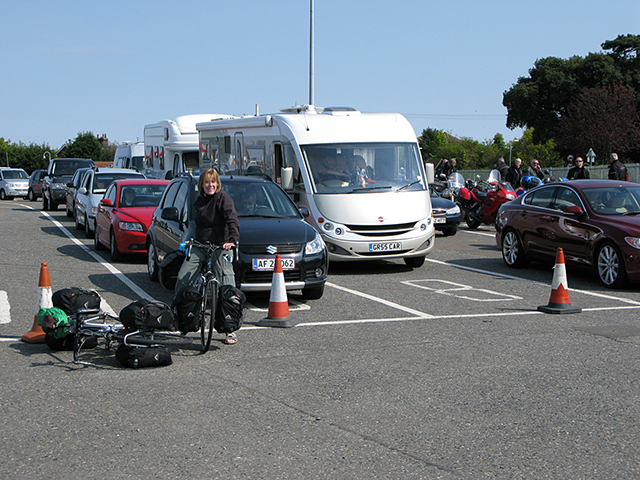
Waiting to board the ferry at Harwich
Several things make Denmark special as a cycle touring destination compared to, say, France, Germany, Switzerland, or Spain. It's cycle-friendly in every way possible: cycling infrastructure, gentle terrain, unsweaty climate, long daylight hours, quiet roads, pleasant accommodation, no blackspots to bypass, and above all a national love of the bicycle. Denmark is a friendly country in other ways too. Its people are polite, the gap between rich and poor is the lowest in Europe, and a sense of contentment seems to pervade the nation.
Sandra and me went there for the first time last year. We landed at the port of Esbjerg with our bikes and set off to camp in the nearby town of Ribe, and the following day we headed East with the aim of getting to Copenhagen in five days or so. Our anti-clockwise loop then brought us back to Esbjerg via Hamlet's castle and a couple of ferry trips. We hadn't booked anything in advance and we had my brother's maps from the 1980s. It was good, but in a few places we'd been lucky to find accommodation. And we got lost a few times.
So this year we had hostels and B&Bs booked in advance, and a route that was planned to the very last turn and loaded onto a Garmin GPS. We didn't book campsites though, and again we were lucky. The woman on reception at Ribe Camping asked:
"Are you Vikings?"
"No, we're from England," said Sandra.
"Cyclings!" replied the woman, "On your bicycles?"
"Ah, yes," we said. "We camped here last year. Can we have a pitch on the open ground at the back?"
The woman marked a pitch on a plan of the campsite, but hesitated, saying it would rain overnight, then offered a cabin at a reduced price. A little while later we noticed all the pitches were actually full because, as it turned out, it was a public holiday weekend. Danish public holidays are something to watch out for as they turn an empty campsite into a full one. They aren't really campsites but caravan parks. The site at Ribe is good, with a large shop and a swimming pool.
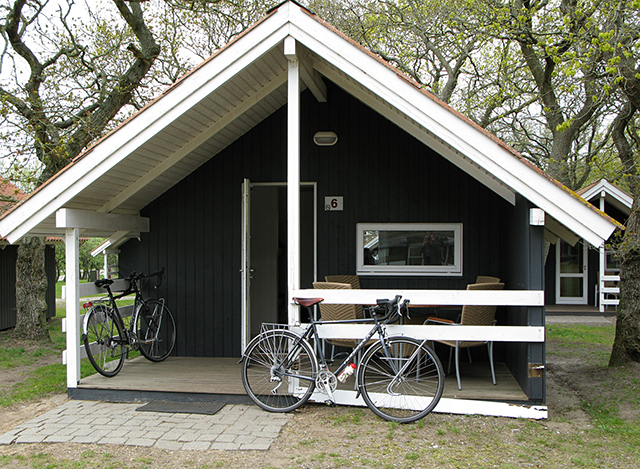
Our camping cabin at Ribe
Danish campsites all seem to have shops, showers, kitchens, and a sitting room where you can dine or watch TV. A few we've been on have an area tucked away for tents but mostly you're amongst the caravans and cabins. It was still raining in the morning. We waited until about ten to see if it would stop, then set off cycling along the road to Tønder 39 miles away. Somewhere around Skærbæk we stopped for coffee and warm apple pie. It was still raining and now I know my Páramo Quito jacket is waterproof, but at Tønder the sun was out.
Tønder Danhostel is right next to the campsite. I did a quick tour of the pitches. The site was completely full of caravans. A couple of pitches were vacant but muddy, and it was cold even in the sunshine. The hostel was deserted so we booked in with the next day's breakfast. We went for a cycle along the river then looked in town for a place to eat later on. Returning to the hostel I suggested to Sandra she might like to see for herself how muddy the last remaining pitch on the campsite was and why the hostel was worth the extra money. The site was now empty! In the space of an hour or so the Danish caravaners had all up and gone.
Our route for day three went off South East deep into the countryside with no towns to pass through until after the forest West of Padborg. This is what we came for. Straight empty lanes under a big blue sky with puffs of white and a following breeze. There's a quietness you rarely hear in England - just the birds and the swish of the tyres on the road. After 20 miles or so I noticed a hatched area criss-crossed on the map of my Garmin and wondered if it was a 'no go' zone like a firing range. It came up to the hedge to our right and looked just a normal field. I mentioned it to Sandra. Then a line came up on the GPS marked 'Danemark' and I realised we were heading into Germany. No. We were in Germany.
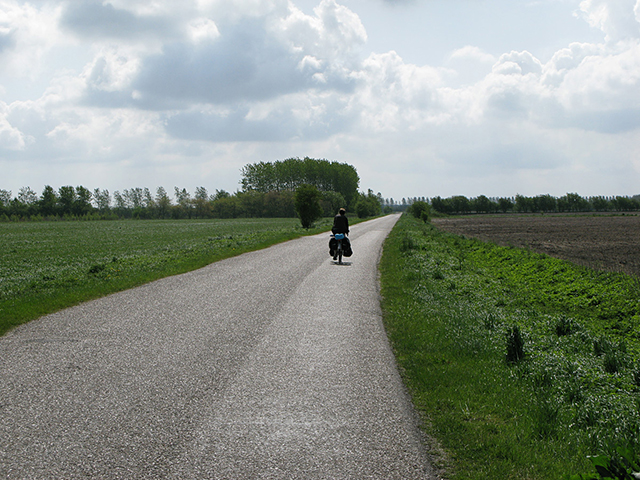
The open road: Sandra en route to Sønderborg from Tønder
After Padborg we dipped into Germany again, at Kupfermüle before turning East in Denmark into another forest at Kollund where you run along the Danish coast with the German coast just across the water. This is sigificant. The campsite manager at Sønderborg suggested we visit a local castle full of old cannons pointing South at the Germans, saying: "1864. The last time we were beaten by Germany." Sandra thought he'd said: "The last time we beat Germany," but I've looked it up since, and he was talking about the Second Schleswig War in which Denmark was beaten by Prussia. There is also the small matter of World War II, but never mind.
After we'd pitched the tent he came up on a ride-on lawnmower and asked us to move it back three metres. Later, in the sitting room, a Danish woman caravaner said she didn't like him because of all his rules and how he kept telling her off as if she was a child. To be fair, the whole place was spotless and the schoolchildren staying in the cabins near to our tent fell silent at 22.00 hours.
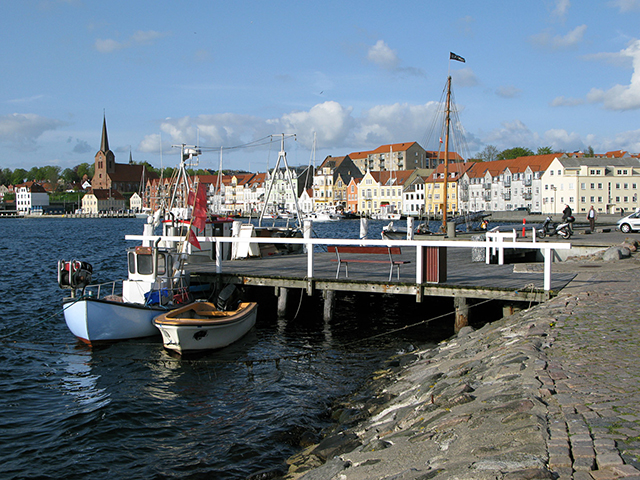
The harbour front at Sønderborg
Day four began with 11 miles cycling North East from Sønderborg to the coast at Fynshav to catch the 10.15 ferry to Bøjden on the island of Fyn (pronounced Foun). Actually, day four began with a cup of tea and some rolls we'd ordered the evening before from the campsite manager, which we collected at eight in the morning. Our Hillberg Nallo 2 GT tent packs up quicker than the panniers. I took a few photos and we were off by by eight thirty, along the Garmin's wiggly line.
I love ferry ports, and even the waiting around. It's much nicer than waiting for a train. While Sandra got the tickets I watched a couple of workmen tamping some concrete with a small machine then one of them lifted a big steel plate onto a lorry with a mechanical digger. As the boat appoached from across the water we laid our bikes down at the front of the queue. Bicycles are always the first on board and Sandra was pleased there was no ramp to cycle up. The sun was beginning to break through a little, but over towards Fyn, an hour away across the Lillebælt, the sky was a very dark grey.
Our plan had been to cycle from the port at Bøjden to Faaborg (we'd stay at the hostel there on our return journey a week later), then on through Svendborg and across a bridge to a campsite at Vindebyør, involving a detour a few miles East of our main track. I'd also planned a pleasant detour on the way in to Svendborg in the form of a scenic route along meandering lanes by the coast. But all this had left us with a big day five, including another ferry trip from Spodsbjerg to the island of Lolland and a further 40 miles or so to a campsite at Guldborg - nearly 60 miles of cycling in all, plus the ferry. And if the campsite was full, it would be too late in the day to find somewhere else to stay, as Guldborg is a very small town.
Before we'd even got to my scenic detour Sandra was looking at her guidebook, thinking we should go all the way to Spodsbjerg. She reckoned the campsite there looked better than the one at Vindebyør, and if it was full there were others to choose from. Day five would then be easier as we'd be straight on the ferry.
On the outskirts of Svendborg my Garmin really came into its own.
"This way."
"Are you sure?"
"Yes!"
I think she found it irritating as if we were being cheated of the fun of finding the way. This may be true but the back lanes we used brought us to exactly the right place.
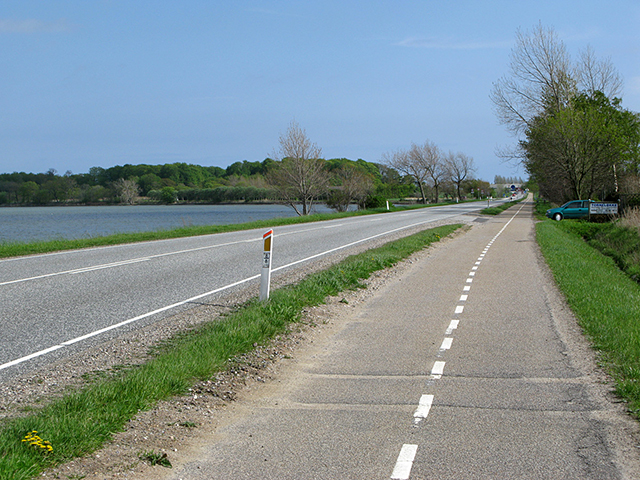
Causeway to Spodsbjerg
As we cycled across more bridges and causeways to the island of Langeland we began to run short of time. Reception on Danish campsites opens only at certain periods of the afternnon: 4 till 6, 5 till 7, 6 till 8, and so on. If you don't arrive by then you'll have no toilet key. With a few miles still to go before Spodsbjerg the main road became 'no cyclists' and a bicycle sign pointed off to the right into the country. I'd seen the absense of a cycle lane when planning the route on Google Earth in March but my Garmin's wiggly line took us off to the left, not the right. To please Sandra (she still didn't trust the GPS) we followed the bicycle sign instead, and wandered in all directions until we arrived at the campsite just as the office was closing.
Day five was bright and sunny with a following wind and gorgeous cycling across the island of Lolland between our landing port of Tårs and Maribo via the pretty town of Nakskov. As we drank coffee in the sunshine in the main square at Maribo we met a young Brian May lookalike English cycle tourist who, as lone travellers often do, told us his life story. Like us, he was heading North towards Copenhagen but he had no map or GPS. We told him he'd have to cross the small bridge at Guldborg, then the mighty Storstrømmen bridge to Vordingborg, and wished him bon voyage.
I'd already studied the Guldborg campsite on Google Earth. When we arrived it was bigger than I'd imagined, run by a pleasant elderly couple who didn't seem bothered by long grass.
"How much are the cabins?" asked Sandra.
"The cabins are cheap!" replied the woman.
We pushed our bikes over the daisies and buttercups to cabin number 5. Inside, it smelt of old clothes. The whole campsite had a run down feel but the toilets and showers were clean. It was full of empty caravans. There's a nice Marina at Guldborg, by the old bridge across to the island of Falster, and a café crowded with people eating beefburgers covered in mayonnaise. We wondered if we'd see Brian May cycling past. We took photographs in the lovely evening light by the water. At the cabin, as well as locking the bikes I put the cover over them. I'm not sure why.

Guldborg marina
We cycled over the bridge early the next morning, day six, and set off to the Storstrømmen bridge under a dull grey photogenic sky. After a few hundred yards I reached for my camera, which I carry slung over my shoulder. It wasn't there. I must have left it on the table outside the cabin. I shouted at Sandra to stop because I've left my camera and raced the mile back to the campsite, panniers and all. Before turning into the gate I looked back down the road and saw Sandra cycling towards me and immediately knew she'd packed my camera in her luggage. Mine and hers are identical cameras with identical cases. She'd found it quickly and called out to me, but I'd shot off too fast. Her speed as she'd cycled back along the road was as impressive as mine!
For me, cycling over the Storstrøm bridge (which crosses the Storstrømmen channel) was to be one of the highlights of our tour. It's over three kilometres long and carries a railway as well as a road. Unlike the nearby bridges at Farø, bicycles are allowed. It was actually a bit of a disappointment and in poor condition. As usual, Sandra didn't waste time getting over but I stopped a few times. The whole structure shook as a train came by en route from Copenhagen to Hamburg. Halfway over a man was holding a fishing line that trailed down to the water. On the Vordingborg side the Garmin led us through town and we were soon on the long straight highway North to Køge, where we aimed to enjoy the same delicious ommelettes as last year at the Café Vanilla.
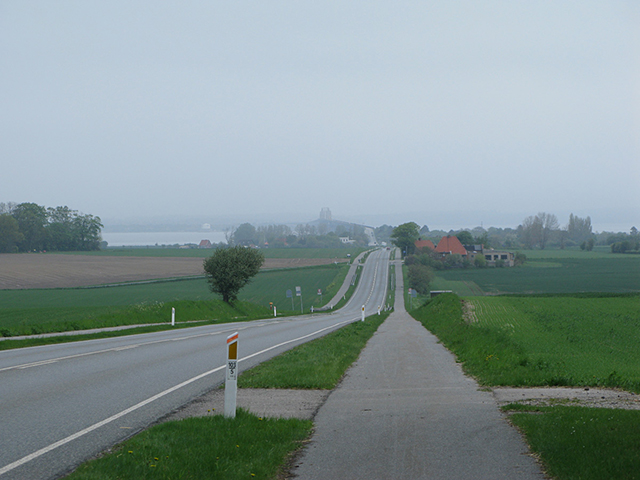
Grey morning approaching the Storstrøm bridge
The rest of the way was a trudge. I liked it but Sandra didn't. We'd come to a long straight perhaps three miles long and rising gradually a couple of hundred feet, then over the brow we'd see the same thing again - down then up, then down then up for mile after mile dead straight. For Sandra's amusement I called out the altitude each time it changed ten feet. In the Café Vanilla we found that ommelettes are on the lunchtime menu only, but the sun was out on a pleasant evening, and Køge Danhostel is excellent.
On day seven we turned West into the prevailing wind towards Korsør on the opposite side of the island of Sjælland. Copenhagen, the Danish capital, is on this island. We cycled through it last year on the way to Hamlet's castle at Helsingør. There wasn't actually much wind on this day and the sky was blue. We stopped for coffee at Ringsted then cycled past our campsite at Sorø, another memory from last year's tour.
The landscape West of Slagelse as you approach Korsør is especially pretty, and you begin to catch glimpses of the magnificent Storbælt road bridge that links Sjælland with Fyn. This was the second public holiday weekend in a row so we expected the Storbælt campsite to be pretty full. We were offered a choice of the only two remaining pitches. We chose the one by the beach, where the view of the bridge is superb. This is an excellent campsite with more toilets and showers per capita than we've ever seen and a clientele of three generations of Danish families. In the evening we cooked pasta then cycled over towards the town. By 10.30 pm the campers were mostly in bed, but even if they hadn't been, we'd have heard nothing over the roar of traffic crossing the nearby bridge.
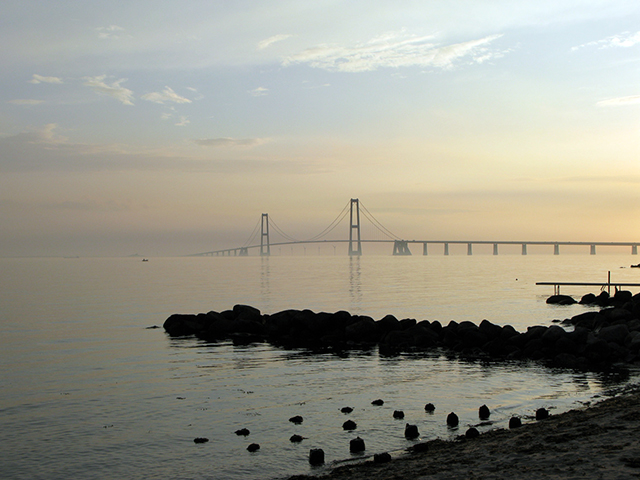
Another bridge: Storbælt (from Korsør)
Unfortunately you cannot cycle over the Storbælt bridge. You catch a train from Korsør station and get off at Nyborg. The train doesn't cross the bridge either, going the best part of the way through a tunnel. As we cycled out of Nyborg towards Odense it began to rain but day eight was going to be a short day. By early afternoon we were knocking on Mette's door. Mette's B&B is a pleasant annex in a garden through an archway. The room is on the ground floor, and upstairs is an open attic with large mirrors round the walls. There are plenty of mirrors downstairs too. The landlady is some kind of therapist and the place was quite sexy.
My brother likes Odense a lot but to us it was just another pleasant Danish town with the usual cobbled precinct and shops that never seem to open. In the centre are some Parisian-style street cafés that are nice to look at but a waste of time and money to sit in. Instead, we had warm apple pie in the sunshine outside an English-style pub, then a bit later went to Macdonald's. As we left in the morning I stole a small blue facecloth from Mette because I thought she'd skimped a little with our pricey breakfast.
Day nine was also supposed to be an easy day: 33 miles to Faaborg via Egeskov Slot, a major castle for sightseers. But near the town of Ringe my Garmin led us towards motorway number 9. This was a stupid mistake on my part when I'd planned the route. To make things worse, the cycle route signs outside the town made no sense. We cycled a few miles in the wrong direction, rode back, and Sandra got the map out. This worked. An elderly Danish couple stopped their car and asked if we were lost. They told us the way to the castle, where we then turned West into a stiff headwind the rest of the way to Faaborg.
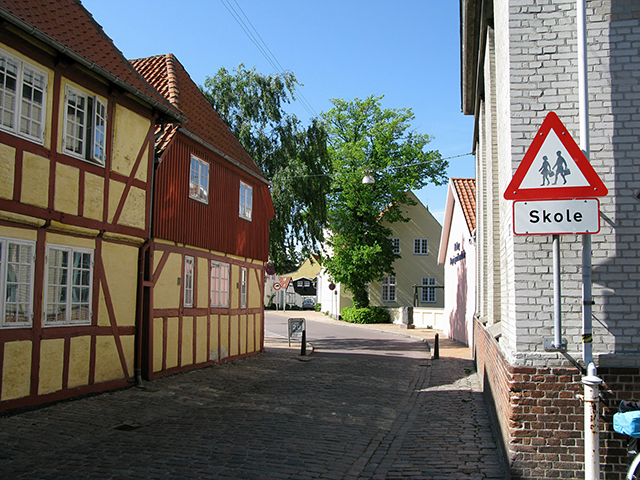
Faaborg Danhostel (on the left)
As we'd learnt to expect, everything in the town was shut, including the hostel, but there's a nice marina - our fifth so far. Like the others it was full of German yachts and again, like the others, there was no-one around. Sandra managed to find some eggs and when the hostel opened she made some cheese ommelettes. Faaborg Danhostel is an olde-worlde collection of buildings with a lovely courtyard sheltered from the wind. The wind had begun to play a part in the progress of our cycle tour, blowing hard, as it was, from the North West.
The next day it rained, but it was another short ride - just 24 miles to Assens. The reason we were going to Assens was mostly the steak and chips we enjoyed there last year, just as we'd revisited Køge for the ommelettes. Would the café be open, we wondered? It rained hard in our faces but it was surprisingly pleasant. Somehow I could still see through my glasses and my head was dry in the hood of my Páramo jacket. Sandra put on her waterproof trousers. Our route took us close to the coast and we arrived in Assens by our sixth marina. We went straight to the café and booked a table for six-thirty. The hostel was empty except for a few migrant workers.
The hostels we've stayed at in Denmark have all been good, but some better than others. Last year at Assens Danhostel some Danish motorcyclists had told us about one of the best there is: a five star hostel up at Fredericia. We'd decided to try it, and day eleven was the day. It began with a scenic ride North up to the main road from Nyborg to Middelfart where you turn West towards the Brovejen bridge leading back to the Danish mainland. The section to Middelfart along this road wasn't much fun even in the sunshine. There was no cycle lane and the wind blew hard, head on. I fell into a ditch by the road and cut my hand. Going North again, over the bridge to Fredericia, was much nicer.
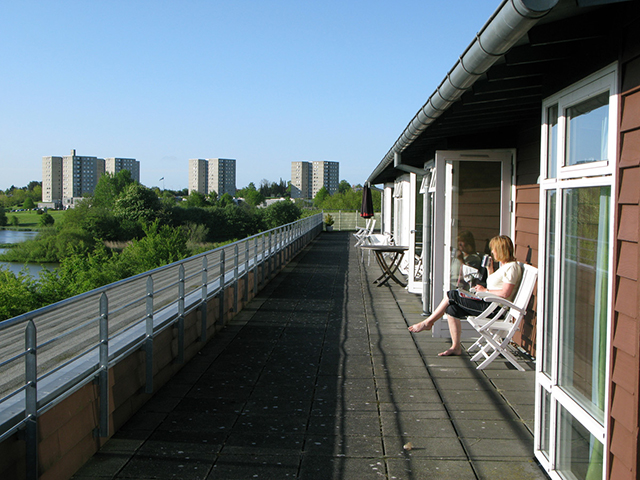
Sandra on the balcony outside our room at Fredericia Danhostel
Fredericia Danhostel resembles an expensive hotel. The only other guests were a few travelling tradesmen and a small group of students, and they were gone by 8.00 am. At breakfast we had the dining room mostly to ourselves. Day twelve was a good 55 miles to Varde on the far side of Jutland, cycling due West into the prevailing wind, and as soon as we'd arrived we'd asked at the desk for a weather forecast. Like today but better, with less wind, the woman had said. We'd already talked about what we might do had the weather been wet and windy as it was two days before. The downside of pre-booking places to stay is that you need to arrive. We'd probably have caught a train. But this was a beautiful day and a gorgeous cross-country route through farmland and forests.
The Garmin led us to Frisvadvej in Varde. Our B&B was somewhere in this street. We'd forgotten to bring the actual address but we knew the landlady's name was Kristen. I'd planned the route right to the front door, so I looked at the GPS map and rode to the house at the end of the wiggly line. Kristen opened the door.
It was a lovely room, with a mock orange tree in full bloom outside the window. I'd recommend it to anyone in need of accommodation close to the port of Esbjerg. Kristen's breakfast provisions were better than Mette's so there would be no need to steal a facecloth. Her website is here on www.visitwestdenmark.com. I doubt if many foreigners visit Varde but it's a nice little town and a good place for a first night off the Harwich ferry.
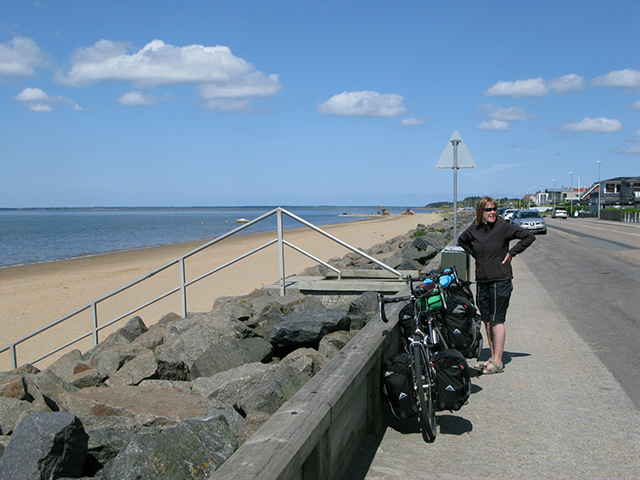
The coast at Hjerting, a few miles North of Esbjerg
All we had to do on day thirteen was cycle 16 easy miles to Esbjerg and hang around in the sunshine for a few hours. First we hung around drinking coffee at Hjerting a little up the coast. Sandra dipped her toes in the sea and we watched our ferry coming in.
The coast down to Esbjerg is lined with bungalows overlooking the ocean. We both admired one in particular: a piece of modern architecture right at the end before you come to the massive quadruple statues called Man Meets the Sea. The Garmin was now redundant. We aimed our bicycles at the tall white chimney that dominates the Esbjerg skyline and is next to the ferry port. But before we made for the port we did what we did last year: Macdonald's in the main square then a pleasant couple of hours watching the Danes go by.
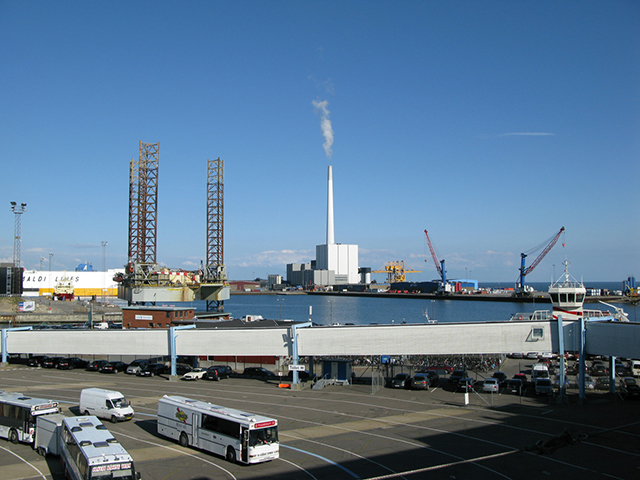
Esbjerg ferry port from the boat
Cycling in Denmark
Despite being the most densely populated country in Europe, Denmark is quiet with little traffic on most of its roads. The population is concentrated around Copenhagen and the next largest cities - Odense and Århus - are small towns by UK standards. Except in residential streets (although often there too) there are dedicated cycle paths along one or both sides of urban roads, often separated from the road by a grass strip. Even in Copenhagen you can cycle right through the city without ever once sharing the surface with a motor vehicle.
Main roads between towns often have a separate cycle path running alongside, sometimes meandering off into woodland before coming close up again at the next junction. These cycle paths can be on both sides of the highway or on one side only with a dotted white line down the centre. If they are numbered with a blue bicycle sign, they are part of the official network of national, regional, and local cycle routes. Some of these routes go off into the country, through fields and forests, winding their way through beauty spots and places to picnic or sit beside a lake.
Not all Danish roads have a cycle path. Main roads sometimes don't and country roads generally don't until you come close to a village or road junction. But motorists in Denmark give cyclists a wide berth and the density of traffic is low, so a vehicle slowing down for a cyclist is less likely to back up drivers behind.
At roundabouts cyclists have priority over motor vehicles. In other words, when you cycle round (anti-clockwise), you have priority over drivers turning off the roundabout. This means that when you turn off it you must give a hand signal to let them know they can also turn off. The cycle lane on a roundabout is often painted blue. The priority system is something of a luxury for cyclists.
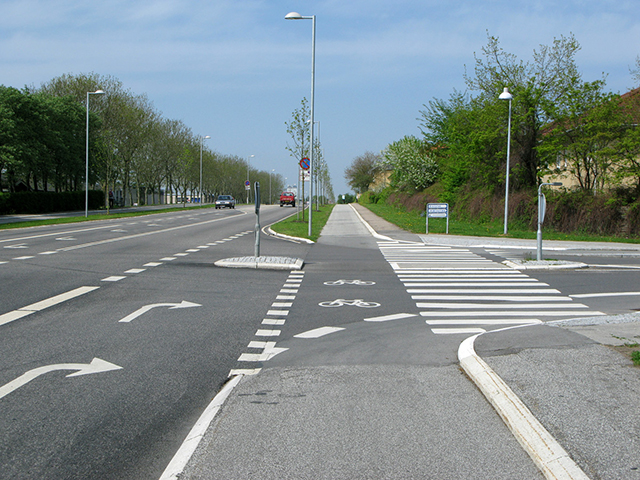
An urban cycle path in Denmark: priority for cyclists
When turning left (equivalent to turning right in the UK) you don't move to the centre of the road. Instead, you stay on the right and position yourself opposite the right lane of the road you want to turn in to, and wait until nothing is coming. Going straight on at a crossroads you have right of way over vehicles turning right. Even if they're ahead of you they must wait if they're in your way. At traffic lights you'll often find a separate set just for cyclists.
Danish towns all seem to have a cobbled precinct in the centre, where you are allowed to ride your bike, although the surface can be very bumpy for the tyres of a loaded tourer. In the evenings and at weekends, town centres are usually deserted except for the odd restaurant. Filling stations are the most reliable places to look for toilets and basic food and drink when everything else is closed. If you're caught short en route you're never far from a patch of woodland.
All young people in Denmark speak English, although it's worth asking: "Do you speak English?" before making the assumption. Older people often don't. We've tried to communicate with elderly people who don't understand a single word. Not even right or left. But they are unfailingly polite. It's hard to reconcile the image of the plundering Viking with the inhabitants of modern Denmark. It is the most peaceful and hospitable place imaginable and the perfect environment for touring on bicycles. For weather and relaxation, the month of May is the time to go.
See also our 2009 cycle tour in Denmark »
Articles »